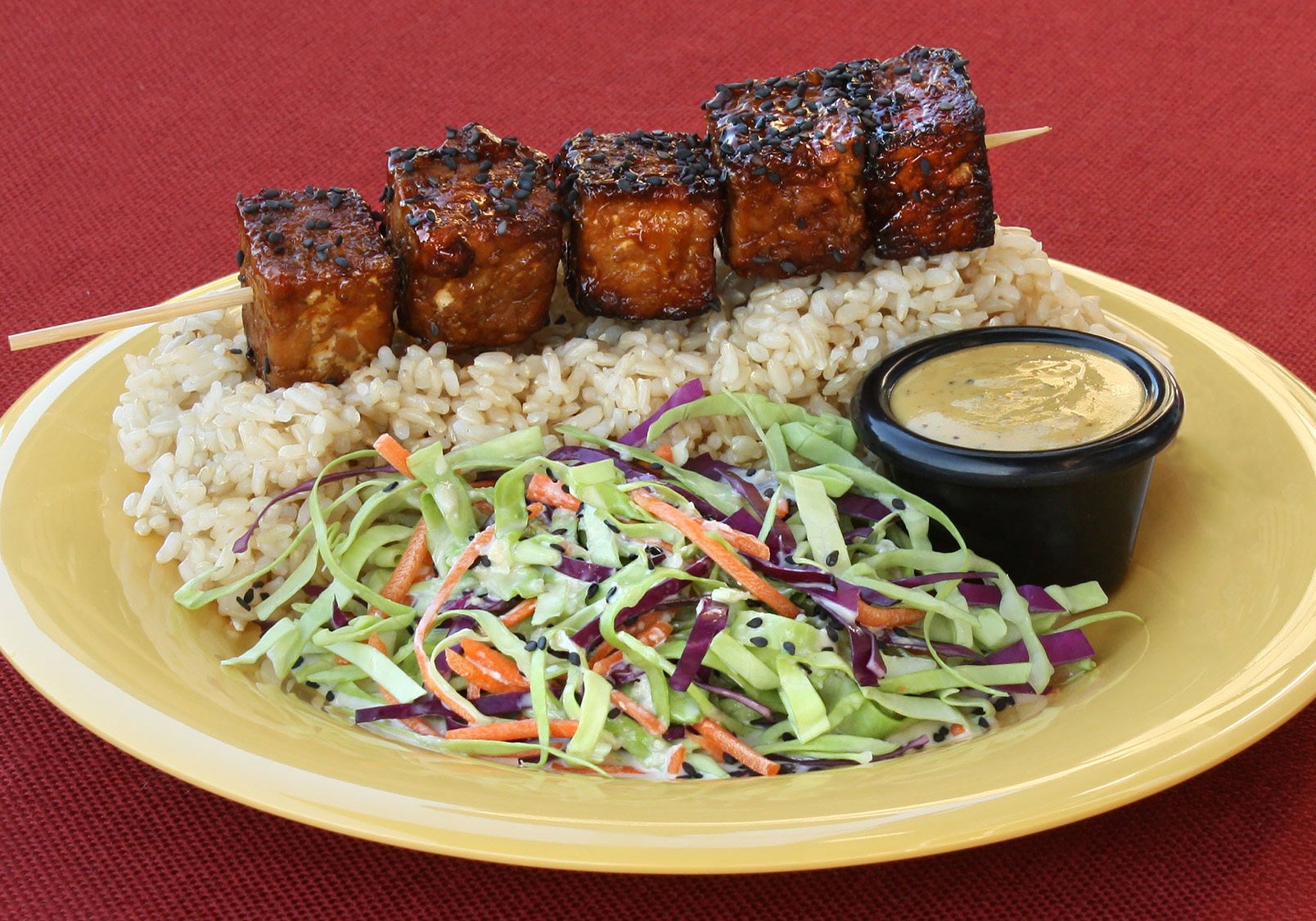
We recently improved our Teriyaki Tempeh by changing how we cut, marinate, and bake the raw tempeh before glazing it for your delight. The new Teriyaki Tempeh is more savory and consistent in size, with even grilling to produce a crisp surface and tender interior. The improvements are all about bold flavor and creating the perfect texture.
Because we have a new, improved recipe, we thought we’d also answer some common questions about Tempeh.
WHAT IS TEMPEH?
While many Americans are unfamiliar with tempeh (tem•pay), this adventurous food is known and loved in other parts of the world.
Tempeh is versatile, nourishing, and tasty with an assertive slightly nutty, slightly mushroom flavor. If “nutty” is not your favorite, rest assured tempeh plays well with other flavors, herbs, and sauces. Tempeh can be marinated or served with a tangy sauce or glaze to take the flavor in a new direction. Our house made Teriyaki Tempeh can be added as a side item or experienced as a Yumm! Bento®.
This traditional food is made from soybeans that uses fermentation to bind the soybeans into a cake form. Tempeh may be eaten raw, but most cooks prefer to marinate it before baking, frying, or grilling it for recipes that cover a wide array of cultural and world flavors and styles.
WHAT IS THE HISTORY OF TEMPEH?
Tempeh has been a favorite Indonesian ingredient since the early 16th Century according to Dutch traders (likely in use for centuries before then). Tempeh is especially popular as a staple source of protein on the island of Java.
Over time, tempeh became popular in other lands. Some of tempeh’s popularity may have more to do with its sustainability than its delicious, adaptable nature for all kinds of cooking. Broadly speaking, it takes less time, land, and resources to produce essential protein with tempeh and soybean-based foods than other methods.
Tempeh attracted fans in America much more recently. The first US mention of tempeh was in a 1946 American Journal of Clinical Nutrition which considered it an “ingredient of valid nutritional properties.” Not exactly a ringing endorsement but nutritionists began to take note.
Western food science soon rediscovered what other cultures already knew: tempeh is an excellent source of protein. Tempeh also provides manganese, copper, fiber, phosphorus, vitamin B2, and magnesium.
Vegans, vegetarians, and health-conscious Americans began trying the ingredient in the ‘60s and ‘70s. Over time, tempeh became known for heart-healthy properties and easily absorbed protein. Other benefits have been explored, and we’ll share additional discussion links below.
If wellness and sustainability aren’t big incentives, you can appreciate tempeh just for its unique craveability.
WHY TEMPEH?
Tempeh is made from soybeans like tofu, but this whole soybean food is less processed with different nutritional qualities. Tempeh’s fermentation process and use of the whole bean give it a higher content of protein, dietary fiber, and vitamins than other soybean-based foods.
Tempeh contains high-quality, complete protein and all the essential amino acids. Due to the fermentation process, tempeh’s protein is easily absorbed and utilized by the body. The more widely accepted health benefits of tempeh include:
- One serving of tempeh (166g) contains 30.8g of protein, or 62% of the Average Daily Value
- Easier to digest than animal based protein
- Contains heart-healthy, unsaturated fat
- Fermented foods boost protein absorption
- Offers probiotics, essential amino acids, and high fiber
The raw tempeh we use at Café Yumm!® is Northwest grown and Oregon produced by a family-run business. Our tempeh is USDA Certified Organic* and non-GMO, made with organic rice and organic millet. Our chef prefers the quality, appearance, and texture of a multi-grain tempeh. We marinate raw tempeh in-house to enhance the flavor profile before later preparation for our Teriyaki Skewer, Tempeh Reuben, or as a lightly-seasoned extra topping for your next Yumm! Bowl®.
Please tell us how you like by letting us know in the restaurant or by using our contact form.
*While our multi-grain tempeh is USDA Certified Organic, ingredients in the teriyaki sauce or the sesame seeds may not be.
Additional Resources:
Fine Dining Lovers: What is Tempeh?
Food Network Healthy Eats
LiveStrong
USDA Abstract
The World’s Healthiest Foods
Self Nutrition Data